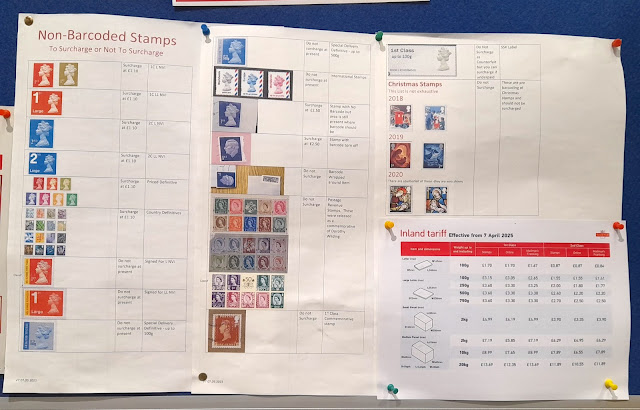In April this year Post Office Ltd announced that ..... the last 108 Directly Managed Branches which are operated by the Post
Office will be franchised by the autumn.
This means that those
communities that currently have a Directly Managed Branch in their area
will continue to be able to access Post Office services either at, or
near to, the same location.
More details have been revealed in the last few days.
It is proposed that 56 Directly Managed Branches will be operated by
three operators from the same premises where they are currently located
whilst the long-term arrangements for the branch are finalised.
RF Retail
With 21 years’ experience in retail and Post Office, Richard Fleetwood,
is the third generation of postmasters. His grandfather and father both ran
branches, and his mother has had several senior roles managing Post
Offices across the UK. RF Retail’s journey began when it opened its
first store in the North East of England in September 2020. They
currently operate six Post Office branches. RF Retail is also the
largest independent operator of Banking Hubs in the UK after operating
the first two in 2021. They currently operate six Banking Hubs. Another
Post Office and Banking Hub are also being planned for this summer.
RFE will operate branches at Bransholme, Bridlington, Caernarfon, Chester-Le-Street, Crossgates, Gloucester, Grimsby, Morley, Nailsea, Oswestry, Redditch, South Shields, and Sunderland City.
UOE
Led by postmaster Elliot Jacobs, UOE operates nine 'Mains' Post
Office branches, a Banking Hub, and a group of award-winning stationery
stores across London, Hertfordshire and Surrey. With 28 years of retail
experience — including over a decade as a Postmaster — Elliot brings
deep expertise in running high-performing, community-driven retail
operations, and is a non-executive director of POL.
Eight of UOE’s nine Post Office branches are former
Directly Managed Branches (DMBs). Together, the UOE network serves over 2
million customers annually and employs more than 60 team members. All
of UOE’s London Stores and Post Offices are open seven days a week.
UOE will operate these branches in London and beyond: Baker Street, Barnet, Brixton, Cambridge City, Golders Green, Hampstead, Harlesden, Harold Hill, High Holborn, Houndsditch, Islington, Kennington Park, Kilburn, Kingsbury, Kingsland High Street, Knightsbridge, Leighton Buzzard, London Bridge, Lower Edmonton, Milton Keynes, Mount Pleasant, Northolt, Oxford, Paddington Quay, Raynes Park, Roman Road Bethnal Green, St Peters Street St Albans, Stamford Hill, Wealdstone, and Windsor.
ZCO
ZCO is a well-established company based in Bolton that operates 21
Post Offices across the UK, which were all former directly managed Post
Offices, as well as four banking hubs. ZCO was founded in 2014 by Zubeir
Patel and now the Managing Director is Tan Musa. He has well-organised
regional teams to assist with the running of Post Offices in England,
Scotland and Wales.
A sister company, called Potent Solutions, set
up in 2008, operates Post Office branches on a temporary basis to
maintain service to communities. However, it is ZCO that is taking on
these new franchised branches. The retail alongside their branches is
traditionally cards and stationery. Bespoke retail also has included
luggage and luggage accessories, souvenirs and beach equipment,
depending upon each unique location.
ZCO will operate across the country: Bexhill-on-Sea, Canning Town, Cricklewood, Dereham, Edinburgh City, Furness House Barrow-in-Furness, Glasgow (West Nile Street), Haddington, Kendal, Kettering, Matlock, Melville Road Hove, Morecambe, Poulton-Le-Fylde, Rotherham, Saltcoats, South Ockendon, and Springburn Way Glasgow.
Firstclass Managerial LTD
Run by postmaster Mikesh Parekh, Firstclass Retail operate thirteen
Post Office branches in and around Greater Manchester, the majority of
which are larger, Mains-style branches. With over fifteen years of
experience as a postmaster, Mikesh has a wealth of experience in running
post offices at the heart of communities. Being a postmaster runs in
the family, with Mikesh having learned from his father at his branch in
Oldham, who himself was a postmaster for fifteen years.
Mikesh
also runs Interim Solutions, which delivers a number of temporary post
offices. Between the two businesses, Mikesh currently operates around 30
branches and employs over 170 staff. Mikesh has a deep commitment to
the community he serves and has a track record of working with local
stakeholders to safeguard Post Office services.
Firstclass will run branches at Barnes Green Manchester, Breck Road Liverpool, Didsbury Village, Eccles, Hyde, Leigh, Old Swan Liverpool, and Salford City.
South Coast Retail
Liam Searle is at the helm of South Coast Retail in Dorset. He is the
third generation of his family connected to Post Office branches. Both
his grandmother and his father worked at Directly Managed Branches as
counter clerks. His father’s career progressed to being an area manager
before he took on Swanage Post Office when it was being franchised. Liam
then took over as postmaster for Swanage in 2019. His Dad still helps
at his Swanage branch and runs the outreach services.
The
36-year-old now also operates successful branches in Dorchester,
Sherborne, Swanage, and Weymouth, plus three outreach services for three
communities in the Swanage area. A banking hub also opens in Sherborne
in June. Liam runs a close-knit company with 50 employees. The retail
offering at his branches is cards, stationery, gifts and soft drinks.
SCR's new branches will be at Bideford, Liskeard, Mutley Plymouth, Newquay, Paignton and Teignmouth.
New operators for about another 30 branches are to be announced and will be added here.


























































